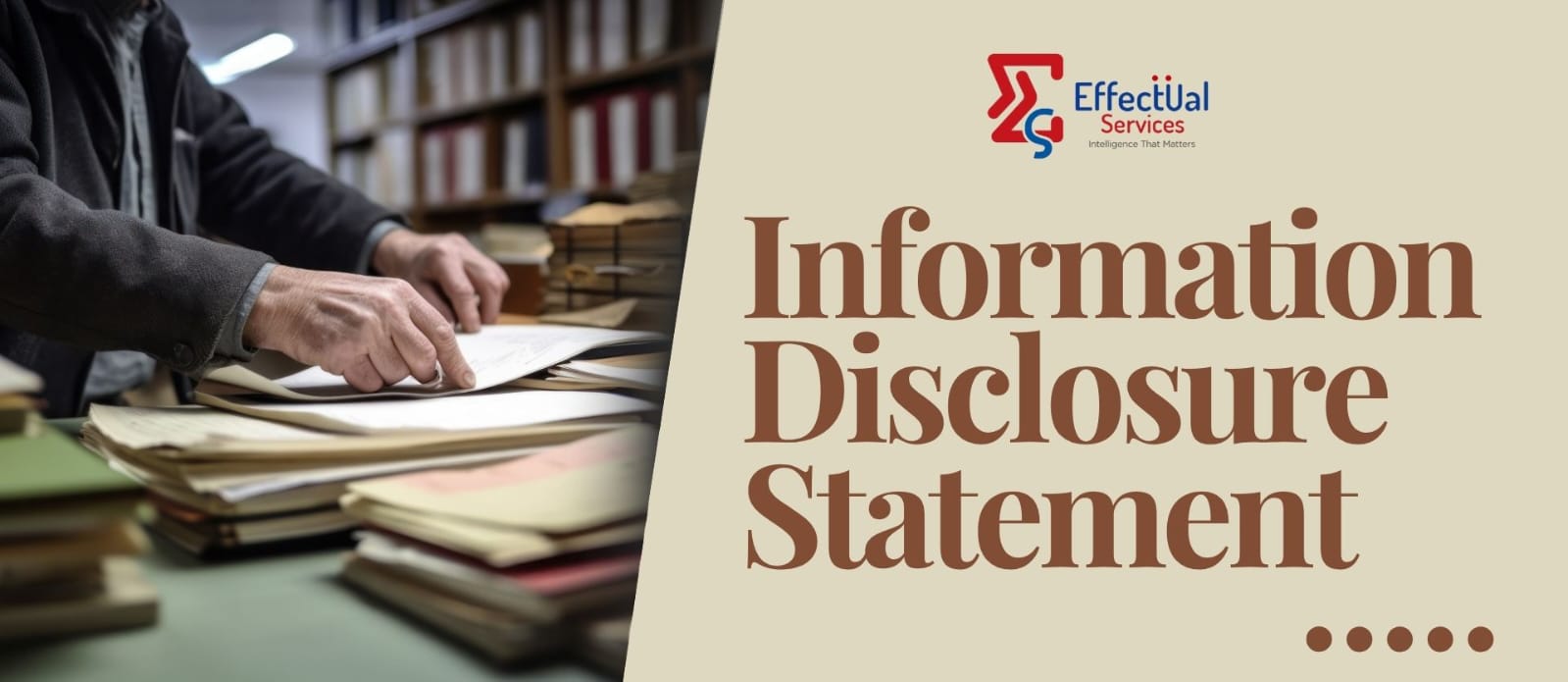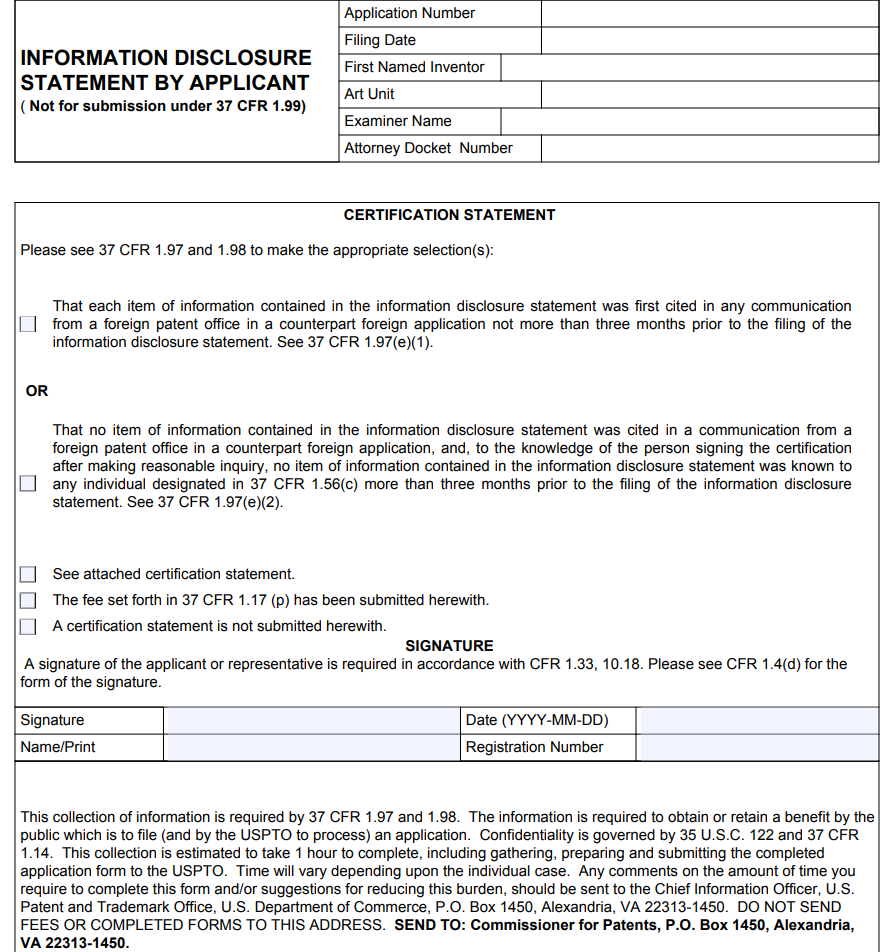IDS Filing Guide: Requirements, Timing & Best Practices

While prosecuting patent applications in the US under the US Patent law, it is the duty of the inventor(s), applicant(s), or attorney(s)/agent(s) representing the applicant to divulge, in good faith, all the known prior art references that are known or discovered during the course of prosecution up to the date of patent issuance (37 C.F.R §1.97), before the United States Patent and Trademark Office (USPTO) in a specified format, known as the Information Disclosure Statement (IDS). The said prior-art references include patent (published applications, issued patents, etc.) and/or non-patent references (all the scientific articles that have appeared in journals, presentations, paper submissions, poster presentations, advertisements, product brochures, doctoral thesis, standards as prescribed, publications, magazines, books, or any other information that there might be) that are material to patentability of the invention (37 C.F.R. §1.56) claimed through the respective application.
Required Documents for IDS Filing
The documents that come to the knowledge of the inventor/applicant, or attorney/agent representing the applicant, e.g., published applications or issued patents that are identified after filing the application.
The references cited by the examiner/controller during office actions of PCT or foreign prosecution of the same (or closely related) application.
The references identified during the International Search Report (ISR) are valid references for IDS submission.
The references from a related PCT application or a foreign patent office examining a foreign counterpart application at later dates can also be filed as supplemental IDS submissions.
Regarding the submission of NPL documents, full-text of the NPL reference based on availability or the level of information publicly available needs to be submitted.
When to file the IDS?
- The procedures and requirements under 37 CFR 1.97 for submitting an information disclosure statement are linked to four stages in the processing of a patent application:
- (1) (a) for national applications (not including CPAs), within three months of filing, or before the mailing of a first Office action on the merits, whichever is later;
- (b) for international applications, within three months of the date of entry of the national stage as set forth in 37 CFR 1.491 or before the mailing of a first Office action on the merits in the national stage application, whichever is later;
- (c) for continued examinations (i.e., RCEs filed under 37 CFR 1.114 and CPAs filed under 37 CFR 1.53(d), before the mailing of a first Office action on the merits;
- (d) for international design applications, within three months of the date of publication of the international registration under Hague Agreement Article 10(3) or before first Office action on the merits, whichever is later.
Who Has a Duty of Disclosure?
Anyone substantively involved in preparation or prosecution of an application, including:
- Inventor(s)
- Attorneys,
- agents,
- paralegals
- In-house patent counsel
Disadvantage for not filing IDS
The duty to disclose the relevant prior art is applicable to every person who goes for preparation of a substantive patent application. And duty is broad to file the statement with respect to any material information that connotes to the novelty of the invention. The US Patent law necessitates the disclosure of the material prior-art references, failure of which can result in the unenforceability of the patent for “inequitable conduct” i.e., deliberate withholding or concealing of the known information, rendering the entire patent useless.
Best Practices Related to IDS Filings
- It is always advisable to file IDS at the time of filing the application itself, followed by subsequent IDS filings.
- Costs associated with IDS filings can be avoided if the same is filed before the issuance of first office action, else stipulated charges are levied for each of the IDS filed.
- When the application concerns multiple counterpart foreign applications and/or related applications, it is advisable to provide all the references cited from a foreign patent office(s).
- At the end of the day there are two reasons why someone should file a USPTO IDS, and a few nuances to be wary of.
- First, every patent applicant has what lawyers call a “duty of candor“, meaning that the applicant has an obligation not to intentionally hide relevant information. Failing to fulfill your duty of candor can be seen as a fraud on the USPTO and cause you to lose your patent.
- An essential part of U.S. patent prosecution is the duty of disclosure, which requires the disclosure of all known information that is material to patentability. 37 C.F.R. § 1.56.


Way Forward
Filing an IDS is a critical step in U.S. patent prosecution, ensuring compliance with the duty of disclosure under 37 C.F.R. §§ 1.56 and 1.97. Timely and complete submission of all relevant prior art—both patent and non-patent—helps avoid extra costs, protects against claims of inequitable conduct, and upholds the enforceability of the patent. Simply put, a well-managed IDS safeguards your patent and strengthens its legal standing.
About Effectual
At Effectual Services, we follow a rigorous and systematic approach to IDS preparation, ensuring that our clients receive a comprehensive and well-organized IDS package that includes ‘what’s new to cite’, ‘what’s already been cited’, ‘what’s not considered by Examiner’, so they can have the complete background and take decisions accordingly.
Solutions Driving Innovation & Intelligence
Enabling Fortune 500's, R&D Giants, Law firms, Universities, Research institutes & SME's Around The Globe Gather Intelligence That
Protects and Nurtures Innovation Through a Team of 250+ Techno Legal Professionals.


